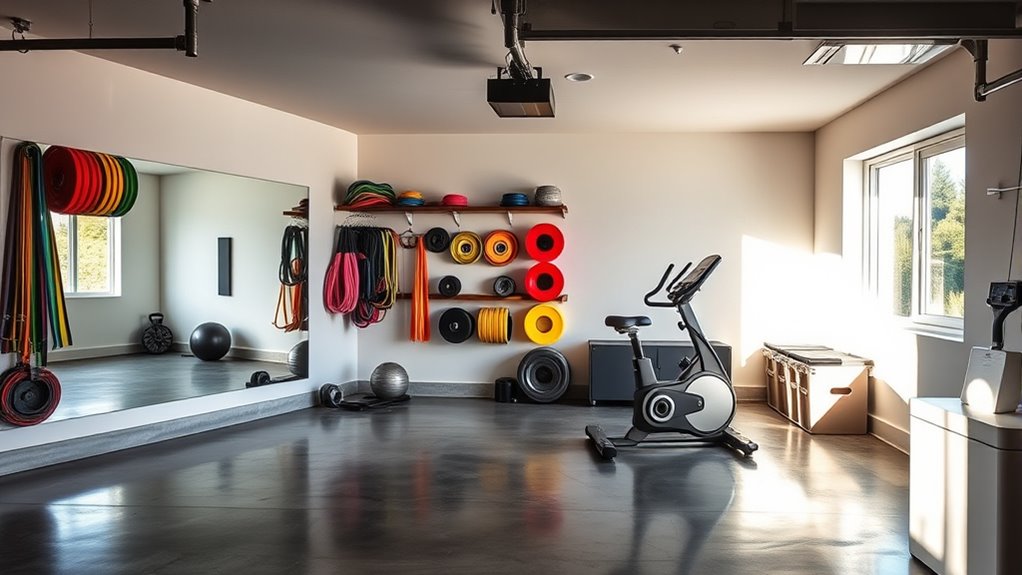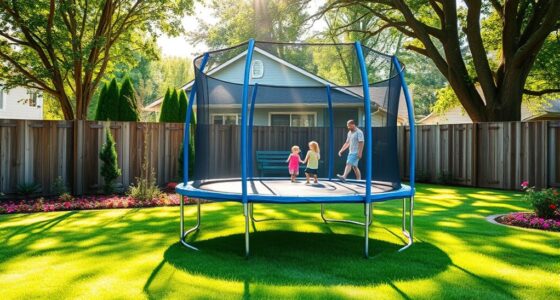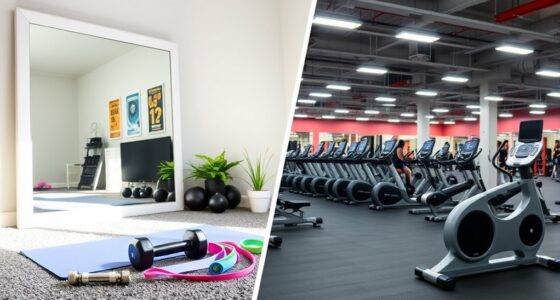Converting your garage into a gym is a cost-effective way to create a dedicated workout space. Expect to spend between $7,500 and $20,000, with costs depending on materials, equipment, and scope. Plan for adequate ventilation, lighting, and storage, and consider structural and legal factors like permits. Focus on safety features and select durable flooring. Want tips on how to maximize your space and budget? Keep going to discover key insights to get started.
Key Takeaways
- Assess structural integrity, insulation, and ventilation to ensure safety and comfort during workouts.
- Budget between $7,500 and $20,000, considering materials, equipment, and permits.
- Plan the layout for efficient space use, including storage, mirrors, lighting, and safety features.
- Obtain necessary permits and adhere to local building codes for legal and safety compliance.
- Select durable flooring and essential workout equipment tailored to your fitness needs.

Ever considered turning your garage into a personalized gym? It’s a smart way to create a dedicated workout space without the high costs of a commercial gym membership. Before diving in, you should know that the total cost varies widely, typically falling between $7,500 and $20,000, or about $18 to $50 per square foot. The average expense hovers around $15,100, but your actual costs depend on factors like your location, materials, and the scope of renovation. Material costs can swing substantially based on the quality and type of finishes you choose, while labor costs usually make up about half of the total budget. If you’re handy, doing some of the work yourself can cut costs, especially for simpler projects.
Planning your budget accurately involves considering permits, the size of your garage, and the level of renovation you want. Converting your garage into a gym can be straightforward and cost-effective if you opt for a basic renovation. For instance, a partial upgrade might cost between $500 and $5,000, covering things like new flooring or lighting. A full remodel, which could include installing new flooring, cabinets, or doors, might range from $3,000 to $17,000. Keep in mind that choosing high-end materials will elevate your costs but can also improve durability and aesthetics. Additionally, understanding the importance of contrast ratio helps in selecting lighting and window placements to optimize your space’s visual comfort.
Basic garage gym upgrades cost $500–$5,000; full remodels range from $3,000–$17,000, depending on materials and scope.
The layout and design of your gym are essential for making the most of your space. Efficient use of the available area guarantees you have enough room for equipment and movement. Incorporating smart storage solutions helps keep your gym organized without cluttering the space. Deciding whether to keep or replace windows and doors impacts both the budget and functionality—keeping windows might save money but could limit ventilation. Proper insulation and climate control are necessary for comfort, especially if you live in a region with extreme temperatures. Flooring choices matter too; rubber mats or specialized gym flooring protect your space and support safe workouts. Proper planning includes assessing the structural integrity of your garage to support additional weight from gym equipment and storage. This ensures your renovation will be safe and durable over time.
Legal requirements add another layer to think about. You might need permits, which can add to your costs, and must adhere to local building codes. Some neighborhoods have restrictions or covenants that could impact your plans. Hiring professionals for inspections ensures your renovation complies with regulations, avoiding costly rework later. Environmental factors, like energy efficiency, might require additional permits, especially if you’re installing new windows or insulation.
Finally, selecting the right equipment and features will make your gym functional and enjoyable. Focus on essential gear suited to your workout style and space constraints. Adding mirrors, good lighting, proper ventilation, and a sound system enhances your workout environment. Safety features like emergency exits and first aid kits are indispensable. Whether you choose to do the work yourself or hire professionals, proper planning guarantees your garage gym becomes a motivating and practical space tailored to your fitness goals.
Frequently Asked Questions
How Much Does Garage Gym Conversion Typically Cost?
You’re wondering about the cost of converting your garage into a gym. Typically, it ranges from $6,000 to $30,000, depending on the size, materials, and features you choose. Smaller, basic setups tend to be less expensive, while adding custom finishes, flooring, lighting, and electrical work increases costs. Hiring professionals can also raise expenses, but DIY options may help you stay within your budget.
What Permits or Regulations Are Needed for Conversion?
You’ll need to verify local regulations before converting your garage. Typically, you’ll require building permits for structural changes, electrical permits for wiring, and possibly plumbing or HVAC permits if you add or modify systems. Zoning approvals are also necessary to ensure compliance with land use rules. Always submit detailed plans, work with licensed professionals, and schedule inspections to stay legal, safe, and protect your property value.
How Do I Ensure Proper Insulation and Temperature Control?
To guarantee proper insulation and temperature control, start by sealing all gaps around walls, windows, and garage doors with weather stripping or caulking. Install insulation with an R-value of R-18 to R-22 in walls and ceilings, and consider higher R-values for vaulted ceilings. Add thick floor mats or insulated flooring to keep the space warm. Use heaters strategically, and consider ceiling fans or vents for air circulation.
What Safety Measures Should I Consider?
You should prioritize safety by securing heavy equipment to walls and using safety straps on power racks to prevent injuries. Keep floors clear with rubber flooring to avoid trips and falls, and make certain there is enough space around equipment for safe movement. Regularly inspect gear for damage, educate users on proper use, and keep a first aid kit nearby. Proper lighting, ventilation, and clear zones also help create a safe workout environment.
How Can I Maximize Storage in a Small Garage Gym?
Imagine transforming your small garage into an efficient gym—what’s your secret weapon? You can maximize storage by using vertical solutions like wall-mounted racks and pegboards for weights and accessories. Modular shelves and multi-tiered racks help organize bulky gear without clutter. Opt for space-saving equipment like adjustable dumbbells and foldable benches. Overhead racks and designated zones keep everything accessible, leaving you more room to focus on your workout and less on chaos.
Conclusion
Transforming your garage into a gym symbolizes reclaiming your space and prioritizing your well-being. It’s more than just adding equipment; it’s about turning your environment into a sanctuary of progress and resilience. As you close the garage door each day, remember you’re sealing away doubts and opening the door to a stronger, healthier you. Your garage isn’t just a space—it’s a foundation for growth, waiting for you to build your best self within it.









